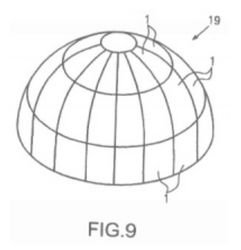Higher Regional Court of Düsseldorf, judgment dated March 14, 2018– docket no. I-15 U 49/16, GRUR-Prax 2018, 309
According to the Higher Regional Court of Düsseldorf, a supplier who supplied all components of a patented device to a customer may, due to its right of prior use arising from this, also be entitled to assemble the device by itself. This presupposes that the former assembly into the protected entire device at the customer's site was "certainly predictable and [could be] easily accomplished". If the assembly is protected by a method claim, it is additionally required that the supplied means can "in technical and economic respects only be reasonably used in accordance with the patent".
Facts and circumstances
The plaintiff is the proprietor of a patent relating to a protective covering for radio systems, components thereof and respective methods of fabrication. A perspective view of a protective covering according to the invention is shown below.

After the date of filing of the patent-in-suit, the Defendant built a so-called spheric radome for a third party, i.e. a dome-shaped covering made of plastic, which is permeable to microwaves and serves as a weather protection. For this purpose, it manufactured the necessary segments and assembled them into a dome.
The spheric radome and the method used for erecting it indisputably realize a device and a method claim of the patent-in-suit. The plaintiff asserted claims against the defendant for injunctive relief, information, rendering of accounts, recall as well as determination of residual redress and damages. The defendant brought a countercomplaint.
It was disputed between the parties whether a right of prior use
existed in favor of the defendant. The defendant particularly
referred to some radomes erected by third parties before the
reference date for which it had manufactured and supplied entire
"construction kits" consisting of the components
(segments) and suitable composite strips. These radomes, however,
were indisputably assembled by third parties only, never by the
defendant itself. Accordingly, the plaintiff held the opinion that
there could be no right of prior use for the direct use of the
technical teaching of the patent-in-suit under attack now. It
stated that the mere manufacturing of components, which perhaps
constituted an indirect use of the teaching in accordance with the
patent-in-suit, could in any case not give rise to a right of prior
use for a direct use of the patent-in-suit.
The decision of the Higher Regional Court of Düsseldorf
The Higher Regional Court substantially dismissed the complaint and substantially allowed the countercomplaint. The Court found that the defendant had indisputably realized the technical teaching of the patent-in-suit, but that it was entitled to use it due to a right of prior use existing in its favor pursuant to Sec. 12 (1) German Patent Act (PatG). The Court stated that the right of prior use followed from the supply of a construction kit for a radome consisting of the radome segments and appropriately cut fabric strips. It was decisive in this regard that the assembly in accordance with the patent by the customer was (i) certainly predictable for the defendant, (ii) easy, and (iii) the only reasonable approach in technical and economic respects.
The reasons for the judgment contain a textbook examination of the right of prior use; the distinguishing element of the present case relates to the specific scope of protection of this right. This is because at the relevant time, the defendant did not perform the construction of protective coverings which is under accuse now, but merely the manufacture and sale of components including a connection solution for a protective covering.
The Senate justifies its conclusion with the recognized principles regarding the scope of the right of prior use, namely that (i) the scope of the right of prior use is basically identical with the content of the exercised possession of the invention, (ii) developments of the prior use that "deepen" the interference with the scope of protection are not covered, but that (iii) the existing right of prior use may cover modifications of the object subject to prior use that lie "within a realization of the patent claim according to the literal sense".
Applying this to the specific case, the Senate affirmed a right of prior use both with respect to the device and the method claim on the following grounds:
- The Court stated that as regards the
device claim, there was a right of prior use, as already the supply
of the components did not only constitute an indirect but already a
direct patent infringement of a combination patent if the assembly
of the individual components into the protected entire device was
certainly predictable and easy to accomplish at the customer's
site. The point of view of the prior user was decisive in this
regard. These requirements were being met in the present case,
which followed, inter alia, from the nature of the supplied
components and the agreed purpose.
Since the right of prior use was thus established by an indirect act of prior use, the Senate concluded that further direct acts of use were also covered by the right of prior use if they do not deepen the interference with the intellectual property right. It stated that such deepening did not exist in the present case, because if the prior user itself began to assemble the manufactured components into the entire device, it did not create a more severe state of interference than it would have done when further supplying the components to a third party that would have assembled them into the patented device. Previously, third parties had virtually acted as its "instrument", and now it carried out the same actions itself. Moreover, this was in line with the "Desmopressin" decision of the German Federal Court of Justice, according to which it was covered by the right of prior use to replace the distribution partners without increasing their number (GRUR 2012, 895, marginal no. 34).
In summary, there is thus a right of prior use with respect to a device claim if the prior user, which has supplied all components for a device, begins to manufacture the device itself, as far as the previous assembly into the protected entire device at the customer's site was certainly predictable and easy to accomplish. - As regards the method claim, a right
of prior use was affirmed as well although supplying objects to a
third party capable of carrying out a patented method was only
classified as indirect patent infringement within the meaning of
Sec. 10 German Patent Act in this case. The Senate stated that this
was because, by way of exception, indirect acts of prior use within
the meaning of Sec. 10 German Patent Act could also give rise to
the right (of prior use) of direct use. A requirement for this was
that the means could be reasonably used in technical and economic
respects only according to the patent. This was to be distinguished
from the case where the supplied components can also be used in a
non-patent-infringing manner and where there is not only a
theoretical but a practically realistic probability of such
use.
The Senate justifies its conclusion in two steps: (i) If the means can be used reasonably in technical and economic respects only in accordance with the patent at all, the indirect prior user would be allowed to offer and supply the means both to its previous customers, which had no right to use the invention, and to any third parties. The Senate stated that all customers of the indirect prior user had a right of direct use – as in the case of direct prior use. Otherwise, the (indirect) right of prior use would be practically worthless. (ii) If, however, the prior user was allowed to supply any third party and any third party was allowed to assemble the device in accordance with the patented method, the prior user itself also had to be allowed to assemble the device itself and thus directly itself realize the patented method, because this could be equated with a "self-delivery" and thus did not constitute a deepening of the interference with the intellectual property right.
In summary, a right of prior use thus exists with respect to a method claim if the prior user which has supplied all components for carrying out a patented method begins to use the method itself, as far as the means previously supplied can be reasonably used in technical and economic respects only in accordance with the patent at all.
Comments
The decision of the Higher Regional Court of Düsseldorf strengthens the position of the suppliers and is essentially convincing. According to the requirements laid down by the Senate, it is basically irrelevant for the relevant question of "deepening" whether the original supplier or the previously supplied third party manufactures the patented device.
However, the question is whether the original supplier may actually begin manufacture in addition to all supplied third parties, i.e. appear on the market as an additional player, or if it is only allowed to replace such a player. The Senate does not expressly deal with this question; however, in the end it considers a coexistence of original suppliers and its customers admissible.
The grounds for the decision are contradictory in this regard. On the one hand, the Senate justifies its conclusion by stating that the supplier is not only allowed to supply its previous customers but also any other third party and therefore also itself. On the other hand, it refers to the Desmopressin decision of the German Federal Court of Justice, according to which "replacing [the distribution partners] without increasing their number" is covered by the right of prior use.
In the Desmopressin decision, the German Federal Court of Justice did not specify whether increasing the number of distribution partners constitutes a deepening of the interference with the intellectual property right or not, because in that case, the distribution partners were only replaced. From the point of view of the supplier, it is therefore advisable, until this question clarified (leave to lodge an appeal on points of law was granted in the present case) to give up (individual) previous customers in the case of a change from supplying to own manufacturing in order to avoid deepening of the interference with the intellectual property right in this regard. However, not only the requirements under patent law but also those under antitrust law should be observed here.
The content of this article is intended to provide a general guide to the subject matter. Specialist advice should be sought about your specific circumstances.

